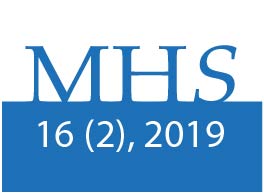Literature Review: Effects of Exercise on Intraocular Pressure
DOI:
https://doi.org/10.15359/mhs.16-2.1Keywords:
intraocular pressure, physical activity, strength exercise, aerobic exercise, glaucomaAbstract
Introduction: The relationship between intraocular pressure (IOP) and acute exercise has been studied in recent years. It has been found that acute exercise has a positive effect on IOP; however, aerobic exercise and strength exercise present different results. As for acute aerobic exercise, it can be mentioned that it provides a positive effect on the intraocular pressure since it decreases, while the strength exercise gives variability in the results obtained according to the research studies consulted. Purpose: Show the results obtained from the investigation related to the aerobic exercise and strength exercise and intraocular pressure in order to provide recommendations to healthy populations with glaucoma. Methods: The literature review searched for articles in the following databases: SportDiscus with complete text, PsycINFO, Psychology and Behavioral Sciences Collection, Rehabilitation & Sports Medicine Source, Google academics, Research Gate, PubMed.Results: Acute aerobic exercise seems to have a significant effect on intraocular pressure: it decreases it. This result occurs in sedentary people with glaucoma. For physically active people or athletes, in order to reduce IOP, it is necessary to exercise at higher intensities compared to sedentary people. Regarding the length of acute aerobic exercise, it seems that, with only 5 minutes, there is a decrease in IOP. At the end of the exercise, the acute effect of aerobic exercise seems to be maintained for a short time in the IOP; more research on the chronic effect is necessary. Also, more research is needed and should involve variables, such as sex and age, within the study analyses and not as descriptive statistics, in order to know the effect of exercise on them. Regarding the strength exercises, the IOP increases in the upper part of the body when compared with exercises in the lower part. High-intensity strength exercises increase the IOP. Conclusions: The results show that people with normal visual condition and glaucoma can perform aerobic exercise, achieving a positive effect on their visual health. On the other hand, there is a lack of research in strength exercise; it is recommended that these studies be conducted at low intensities, according to the data obtained in this review. Regarding the quality of the studies found, the designs could be improved in the investigations. Most of these studies did not have control groups, nor did they specify the intensity; besides, they missed including descriptive aspects needed to be able to have more accurate information.
References
Ahmad, I (1995). The effects of Mild, moderate and severe Exercise on intraocular Pressure in Glaucoma Patients. Japanese Journal of Physiology, 45, 561-569.
Aspinall, P. A., Johnson, Z. K., Azuara-Blanco, A., Montarzino, A., Brice, R., & Vickers, A. (2008). Evaluation of Quality of Life and Priorities of Patients with Glaucoma. Investigative Opthalmology & Visual Science, 49(5), 1907. doi: 10.1167/iovs.07-0559
Avunduk, A. M., Yilmaz, B., Şahin, N., Kapicioglu, Z., & Dayanır, V. (1999). The Comparison of Intraocular Pressure Reductions after Isometric and Isokinetic Exercises in Normal Individuals. Ophthalmologica, 213(5), 290-294. doi: 10.1159/000027441
Bakke, E. F., Hisdal, J., & Semb, S. O. (2009). Intraocular Pressure Increases in Parallel with Systemic Blood Pressure during Isometric Exercise. Investigative Opthalmology & Visual Science, 50(2), 760. doi: 10.1167/iovs.08-2508
Ceguera y discapacidad visual. (s. f.). Recuperado de http://www.who.int/es/news-room/fact-sheets/detail/blindness-and-visual-impairment
Chong, C. W., Wang, S. B., Jain, N. S., Bank, C. S., Singh, R., Bank, A., … Agar, A. (2016). Comparison between intraocular pressure spikes with water loading and postural change: WDT-ST study. Clinical & Experimental Ophthalmology, 44(9), 768-775. doi: 10.1111/ceo.12777
Conte, M., & Scarpi, M. J. (2014). A comparison of the intraocular pressure response between two different intensities and volumes of resistance training. Revista Brasileira de Oftalmologia, 73(1). doi: 10.5935/0034-7280.20140005
Dane, S., KoçEr, I., Demirel, H., üçOk, K., & Tan, üNer. (2006). Effect of acute submaximal exercise on intraocular pressure in athletes and sedentary subjets. International Journal of Neuroscience, 116(10), 1207-1214. doi: 10.1080/00207450500516461
Dimitrova, G., & Trenceva, A. (2017). The short-term effect of yoga ocular exercise on intra-ocular pressure. Acta Ophthalmologica, 95(1), e81-e82. doi: 10.1111/aos.12850
Era, P., Pärssinen, O., Kallinen, M., & Suominen, H. (2009). Effect of bicycle ergometer test on intraocular pressure in elderly athletes and controls. Acta Ophthalmologica, 71(3), 301-307. doi: 10.1111/j.1755-3768.1993.tb07139.x
Esfahani, M., Gharipour, M., & Fesharakinia, H. (2017). Changes in intraocular pressure after exercise test. Oman Journal of Ophthalmology, 10(1), 17. doi: 10.4103/0974-620X.200689
Gallardo, M. J., Aggarwal, N., Cavanagh, H. D., & Whitson, J. T. (2006). Progression of glaucoma associated with the Sirsasana (headstand) yoga posture. Advances in Therapy, 23(6), 921-925. doi: 10.1007/BF02850214
Harris, A., Malinovsky, V., & MartinX, B. (1994). Correlates of acute exercise-induced ocular hypotension.,35(11).
Huang, R. (2015). The Effect of Dynamic and Isometric Exercise on Refractive State, Accommodation and Intra-Ocular Pressure. Advances in Ophthalmology & Visual System, 2(3). doi: 10.15406/aovs.2015.02.00047
Instituto Nacional de Estadística y Censos (Costa Rica) (Ed.). (2014). Costa Rica a la luz del Censo del 2011. San José, Costa Rica: Autor.
Jasien, J. V., Jonas, J. B., de Moraes, C. G., & Ritch, R. (2015). Intraocular Pressure Rise in Subjects with and without Glaucoma during Four Common Yoga Positions. PLOS ONE, 10(12), e0144505. doi: 10.1371/journal.pone.0144505
Karabatakis, V. E., Natsis, K. I., Chatzi balis, T. E., Lake, S. L., Bisbas, I. T., Kallinderis, K. A., & Stangos, N. T. (2004). Correlating Intraocular Pressure, Blood Pressure, and Heart Rate Changes after Jogging. European Journal of Ophthalmology, 14(2), 117-122. doi: 10.1177/112067210401400206
Kinoshita, T., Mori, J., Okuda, N., Imaizumi, H., Iwasaki, M., Shimizu, M., … Mitamura, Y. (2016). Effects of Exercise on the Structure and Circulation of Choroid in Normal Eyes. PLOS ONE, 11(12), e0168336. doi: 10.1371/journal.pone.0168336
Kozobolis, V. P., Detorakis, E. T., Konstas, A. G., Achtaropoulos, A. K., & Diamandides, E. D. (2008). Retrobulbar blood flow and ophthalmic perfusion in maximum dynamic exercise. Clinical & Experimental Ophthalmology, 36(2), 123-129. doi: 10.1111/j.1442-9071.2007.01646.x
Leighton, D. A. (1972). Effect of walking on the ocular tension in open-angle glaucoma. British Journal of Ophthalmology, 56(2), 126-130. doi: 10.1136/bjo.56.2.126
Martin, B., Harris, A., Hammel, T., & Malinovsky, V. (1999). Mechanism of exercise-induced ocular hypotension, 40(5), 5.
Okuno,T., Sugiyama, T., Kohyma M., kojima, S, Oku H & Ikeda T (2006). Ocular blood flow changes after dynamic exercise in humans. Eye, 20,796-800.
Ozmerdivenli, R., Simsek, E., Bulut, S., Karacabey, K., & Saygin, O. (2006). Comparison of the effects of acute an regular exercise on intraocular pressure in turkish athlete and sedentarians. International Journal of Neuroscience, 116(3), 351-360. doi: 10.1080/00207450500442288
Qureshi, I.A., Xi, X.R., Huang, Y.B & Wu, X.D. (1996). Magnitude of decrease in intraocular pressure depends upon intensity of exercise. Korean J. Ophalmol, 10, 109-115.
Read, S. A., & Collins, M. J. (2011). The short-term influence of exercise on axial length and intraocular pressure. Eye, 25(6), 767-774. doi: 10.1038/eye.2011.54
Roddy, G. (2014). Reductions in Intraocular Pressure After Acute Aerobic Exercise: A Meta-Analysis. Clin J Sport Med, 24(5), 9.
Rüfer, F., Schiller, J., Klettner, A., Lanzl, I., Roider, J., & Weisser, B. (2014). Comparison of the influence of aerobic and resistance exercise of the upper and lower limb on intraocular pressure. Acta Ophthalmologica, 92(3), 249-252. doi: 10.1111/aos.12051
Soares, A. S., Caldara, A. A., Storti, L. R., Teixeira, L. F. M., Terzariol, J. G. T., & Conte, M. (2015). Variation of intraocular pressure in resistance exercise performed in two different positions. Revista Brasileira de Oftalmologia, 74(3). doi:10.5935/0034-7280.20150033
Vera, J., García-Ramos, A., Jiménez, R., & Cárdenas, D. (2017). The acute effect of strength exercises at different intensities on intraocular pressure. Graefe’s Archive for Clinical and Experimental Ophthalmology, 255(11), 2211-2217. doi: 10.1007/s00417-017-3735-5
Vera, J., Jiménez, R., Redondo, B., Cárdenas, D., & García-Ramos, A. (2018). Fitness Level Modulates Intraocular Pressure Responses to Strength Exercises. Current Eye Research, 1-7. doi: 10.1080/02713683.2018.1431289
Vieira, G. M. (2006). Intraocular Pressure Variation During Weight Lifting. Archives of Ophthalmology, 124(9), 1251. doi: 10.1001/archopht.124.9.1251
Yan, X., Li, M., Song, Y., Guo, J., Zhao, Y., Chen, W., & Zhang, H. (2016). Influence of Exercise on Intraocular Pressure, Schlemm’s Canal, and the Trabecular Meshwork. Investigative Opthalmology & Visual Science, 57(11), 4733. doi: 10.1167/iovs.16-19475
Zhu, M. M., Lai, J. S. M., Choy, B. N. K., Shum, J. W. H., Lo, A. C. Y., Ng, A. L. K., … So, K. F. (2018). Physical exercise and glaucoma: a review on the roles of physical exercise on intraocular pressure control, ocular blood flow regulation, neuroprotection and glaucoma-related mental health. Acta Ophthalmologica 96(6) doi: 10.1111/aos.13661
Published
How to Cite
Issue
Section
License
General conditions
MHSalud: Journal in Human Movement Sciences and Health by the Universidad Nacional is cover under a Creative Commons Atribución-NoComercial-SinDerivadas 3.0 Costa Rica license.
The journal is hosted in open access repositories such as the Institutional Repository of the Universidad Nacional, the Kimuk Repository of Costa Rica and La Referencia.
The editorial source of the journal must be recognized. Use the doi identifier for this purpose.
Self-archiving policy: The journal allows the self-archiving of the articles in their peer-reviewed version, edited and approved by the Editorial Board of the Journal to be available in Open Access through the Internet. More information in the following link: https://v2.sherpa.ac.uk/id/publication/25815



















